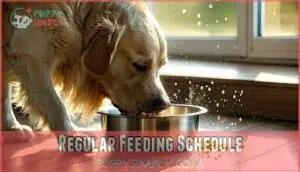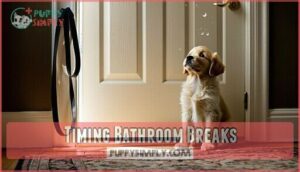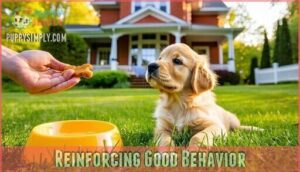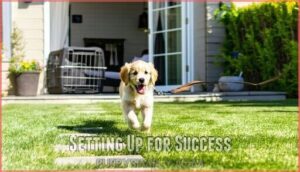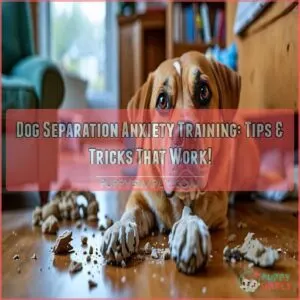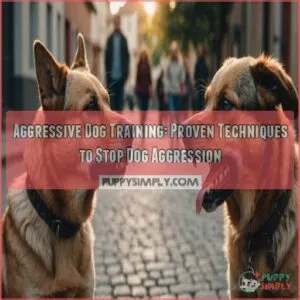This site is supported by our readers. We may earn a commission, at no cost to you, if you purchase through links.
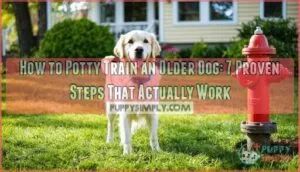
Take your dog outside on a leash to the same spot each time, and reward them immediately when they eliminate outdoors. Clean any indoor accidents thoroughly with an enzyme cleaner to remove lingering odors.
Supervise your dog closely indoors, watching for sniffing or circling behaviors that signal they need to go out. Adult dogs actually learn faster than puppies because they have better bladder control and longer attention spans.
The secret lies in understanding your dog’s unique signals and timing patterns. This approach allows you to teach an old dog new tricks effectively, leveraging their ability to learn and adapt to new habits, especially in the context of establishing a consistent routine.
Table Of Contents
- Key Takeaways
- Potty Training Older Dogs
- How to Potty Train
- Creating a Potty Schedule
- Reinforcing Good Behavior
- Setting Up for Success
- Frequently Asked Questions (FAQs)
- How do you potty train an older dog?
- Are older dogs potty trained?
- How long does it take to potty train a senior dog?
- Can You potty train an older dog using a crate?
- What is the difference between potty training a puppy and an adult?
- Should you potty train an older dog with Pee pads?
- Can an older dog still be potty trained?
- How do you train an older dog not to pee and poop in the house?
- How to housebreak a senior dog?
- How do I stop my dog from peeing and pooping in the house?
- Conclusion
Key Takeaways
- You’ll establish a consistent routine with regular feeding times and scheduled bathroom breaks every 2-3 hours, taking your dog to the same outdoor spot each time and rewarding them immediately for eliminating outside.
- You should supervise your dog closely indoors, watching for sniffing or circling behaviors that signal they need to go out, since adult dogs actually learn faster than puppies due to better bladder control and attention spans.
- You’ll use positive reinforcement by giving treats and praise immediately after outdoor elimination, while avoiding punishment for accidents and instead cleaning them thoroughly with enzyme cleaners to remove lingering odors.
- You can leverage crate training as a powerful tool since dogs naturally avoid soiling their sleeping space, making the crate a cozy den that teaches bladder control while providing comfort during the training process.
Potty Training Older Dogs
Potty training an older dog presents unique challenges, but it’s absolutely achievable with the right approach and patience.
While adult dogs may have established habits from previous living situations, they also possess advantages like better bladder control and faster learning abilities that can work in your favor.
Challenges in Potty Training
Potty training an older dog feels like teaching your grandmother to text – it’s possible, but you’ll face some unique hurdles.
Training an adult dog is like updating old software – it takes patience, but the results are worth it.
Unlike puppies, senior dogs arrive with baggage that complicates the process.
Here are five common dog potty training challenges you’ll encounter:
- Prior training gaps – Previous owners may have skipped housebreaking entirely
- Limited indoor environments – Dogs who’ve never lived inside struggle with new rules
- Medical conditions – Senior dog accidents often stem from underlying dog health issues
- Ingrained habits – Established habits from years of different routines resist change
- Shelter regressions – Rescue dogs may have forgotten housebreaking after kennel stress
These dog behavior issues require patience, but they’re absolutely manageable with the right approach.
Establishing a consistent bathroom schedule is essential for success.
Advantages of Training Adult Dogs
Despite common misconceptions, adult dog potty training offers significant advantages over puppy training.
Your older dog can hold elimination for hours, dramatically reducing accidents throughout your home.
Faster learning occurs because mature dogs focus better and understand routine implementation more quickly, which enhances bonding potential and strengthens your relationship.
This positive reinforcement and proven dog training methods accelerate success in modifying dog behavior patterns, leading to faster learning.
Establishing a Routine
Building a rock-solid routine becomes your secret weapon for successful adult dog potty training.
Start with consistent mealtime feeding—no free-choice grazing allowed. Create scheduled potty breaks using leash guidance, taking your dog out after meals, upon waking, and before bed.
Crate integration during unsupervised moments prevents accidents. A key element is to use positive reinforcement techniques when they eliminate successfully.
These predictable breaks establish your dog training routine within weeks, not months, making consistent mealtime feeding and scheduled potty breaks crucial for a successful outcome with positive reinforcement.
How to Potty Train
When you start potty training older dogs, success depends on three essential elements working together.
Adult dog housetraining requires patience, but these proven steps deliver results:
- Start with crate introduction – Your dog’s safe space becomes their training foundation
- Master signal training – Learn your dog’s bathroom cues like pacing or whining
- Apply troubleshooting tips – Address setbacks with reward consistency and proper potty training tools
These older dog potty training fundamentals set you up for victory before diving into scheduling specifics.
You might also consider potty bell training for better communication.
Creating a Potty Schedule
You’ll need to establish a consistent potty schedule that works with your dog’s natural rhythms and your daily routine.
A structured approach with regular feeding times and frequent bathroom breaks creates predictable patterns that help your older dog succeed faster, using a structured approach.
Regular Feeding Schedule
Set up consistent meal times and you’ll discover the secret to predictable elimination patterns.
Feed your dog at the same hours daily, then remove food dishes after 10-15 minutes to establish regulated patterns.
Avoiding free-feeding creates a reliable dog potty schedule that syncs with your dog’s natural routine.
This feeding schedule makes accidents far less likely while supporting healthy water intake management, leading to a more predictable and manageable routine with reliable dog potty schedule.
Leashed Bathroom Breaks
While many dog owners assume their fenced yard eliminates the need for leashes, using a dog leash during potty breaks creates structured potty opportunities that accelerate training.
Leash training provides leash enrichment while helping you monitor your dog’s elimination habits and recognize dog potty signals effectively.
- Use cue words like "go potty" consistently during each leashed bathroom break
- Monitor surface preference to understand where your dog feels most comfortable eliminating
- Provide walk rewards after successful outdoor elimination to reinforce positive behavior
- Maintain close supervision with the dog leash to catch signals and prevent wandering
- Follow your dog potty schedule religiously, taking leashed walks at predetermined times
Timing Bathroom Breaks
Perfect timing makes potty training older dogs successful. Take your dog out at consistent intervals – every 30 minutes to one hour initially.
Create predictable patterns: first thing morning, after meals, before bed, and overnight breaks for seniors with age-related needs. Many owners find success using a consistent potty schedule.
Don’t skip trips during inclement weather; frequent potty breaks establish reliable dog elimination habits and prevent accidents indoors, which is crucial for successful training and maintaining a reliable dog.
Using a Crate for Training
A dog crate becomes your secret weapon for potty training success. Think of it as creating a cozy bedroom where accidents rarely happen since dogs naturally avoid soiling their sleeping space.
Here’s your crate training roadmap:
- Choose the right crate size – Your dog should stand, turn around, and lie down comfortably
- Make crate introduction gradual – Use treats and positive association to build comfort
- Create a safe space – Add soft bedding and favorite toys for anxiety reduction
- Practice patience – Crate training adult dogs takes time, but consistency pays off
Never force your pup inside or use the crate as punishment. Instead, toss high-value treats inside and let curiosity work its magic.
With proper crate training tips, you’ll establish a reliable bathroom routine while giving your dog their own personal retreat. Crate-training offers benefits, such as providing a safe and private space for your older dog.
Reinforcing Good Behavior
When your older dog successfully goes potty outside, you’ll want to celebrate that victory with immediate rewards like high-value treats and enthusiastic praise.
This positive reinforcement teaches your dog that outdoor elimination leads to good things, making them more likely to repeat the behavior and ask to go outside next time, which is a result of immediate rewards.
Rewarding Outdoor Elimination
Timing’s everything when rewarding outdoor elimination.
Give treats and verbal praise immediately after your dog finishes going potty outside.
This instant positive reinforcement creates a clear connection between the behavior and reward.
Follow up with favorite activities like a longer walk or playtime.
Consistent rewards and clicker training reinforce this essential habit in potty training older dogs.
Responding to Potty Signals
Learning to read your dog’s body language transforms potty training success. Dogs communicate through subtle cues that signal their bathroom needs, and your immediate response reinforces this natural communication system.
Watch for these key dog signals:
- Pacing, whining, or restless movement near doors
- Circling, sniffing floors, or sudden alertness
- Scratching at doors or giving you direct eye contact
Consistent reaction to these cues builds reliable signal training and prevents accidents, which is crucial for successful communication.
Avoiding Punishment for Accidents
When your dog has accidents indoors, resist the urge to scold or punish.
Dog punishment creates fear-based behaviors and destroys the trust you’re building.
Instead, clean accidents quietly without drama.
Your dog won’t connect punishment with past mistakes anyway.
Positive reinforcement works better than negative reactions, preventing training regression while maintaining your dog’s confidence throughout the learning process.
Some owners also find success by implementing effective distraction techniques when undesirable behaviors arise.
| What NOT to Do | Why It Backfires |
|---|---|
| Yell or scold after accidents | Creates anxiety and fear-based behaviors |
| Rub nose in mess | Doesn’t teach anything, damages trust |
| Hit or physically punish | Builds fear, not understanding |
| Drag dog to accident spot | Confuses timing, increases stress |
| Show anger or frustration | Dog associates you with negative emotions |
Cleaning Accidents and Eliminating Odors
Beyond avoiding punishment, proper cleanup prevents repeat accidents in the same spots.
Clean accidents thoroughly to prevent your dog from returning to the same trouble spots again and again.
Dogs return to areas where they smell lingering odors, making thorough cleaning your secret weapon against future mishaps.
Here’s your accident cleanup arsenal:
- Blot immediately – Don’t rub, just soak up moisture with paper towels
- Apply enzyme cleaner – Let it penetrate deep into fibers and subfloors
- Use a blacklight – Reveals hidden stains your nose can’t detect
- Choose pet stain cleaner – Regular cleaners won’t eliminate dog-specific odors
- Protect surfaces – Cover area until completely dry to prevent re-soiling
For effective cleaning, consider using specific enzyme products designed for pet odors.
Setting Up for Success
Success in potty training your older dog starts with proper supervision and smart confinement strategies that prevent accidents before they happen.
You’ll need to watch for subtle signs like sniffing, pacing, or whining, then respond quickly to build the outdoor bathroom habit your dog needs to master, which is a key part of potty training.
Supervising Your Dog
When you’re not actively watching your older dog, leash supervision keeps them close and prevents sneaky accidents.
Constant observation during early training stages helps you catch those subtle warning signs before mishaps happen.
You’ll gradually earn indoor freedom as your dog proves reliable, but accident prevention requires your full attention initially.
Think of yourself as a detective watching for clues, using positive reinforcement, like high-value treats, which can be very effective.
Proper Confinement Techniques
Smart confinement sets your older dog up for success without feeling trapped.
Choose the right crate size where they can stand and turn around comfortably, creating a safe space rather than punishment. Start with gradual introduction using treats and praise.
Dog pens or baby gates work well too. Understanding proper crate dimensions is essential for your dog’s comfort.
Always supervise freedom periods, expanding their space as accidents decrease through consistent crate training.
Recognizing Signs That Your Dog Needs to Go Out
Your dog’s body language speaks volumes when nature calls.
Watch for subtle cues like sniffing behavior around doors, pacing signals near exits, or whining signs while staring at you.
These dog behavior signals prevent accidents through careful dog observation.
Circle-walking, restlessness, and sudden alertness are reliable indicators your dog needs immediate outdoor access for eliminating.
The ability to recognize these signs is crucial for immediate outdoor access, allowing you to respond promptly to your dog’s needs and prevent accidents.
Dealing With House Soiling Problems
Despite your best efforts, house soiling problems can persist in older dogs due to medical causes, anxiety, or deeply ingrained habits.
First, schedule a vet visit to rule out health issues.
Use enzyme cleaners for complete odor elimination, as lingering scents trigger repeat accidents.
Address marking behaviors by restricting access to problem areas while reinforcing positive bathroom routines outdoors, using enzyme cleaners for complete odor elimination helps prevent repeat accidents, and rule out health issues to ensure a comprehensive approach.
Frequently Asked Questions (FAQs)
How do you potty train an older dog?
Surprisingly, 80% of adult dogs can be successfully house-trained within weeks.
Establish consistent feeding schedules, use leash supervision, reward outdoor elimination immediately with treats, and maintain frequent potty breaks every hour until habits form, which helps with consistent training.
Are older dogs potty trained?
Many older dogs aren’t fully potty trained when you adopt them.
They might’ve lived outdoors, lacked proper training, or developed bad habits in shelters.
You’ll likely need to start housebreaking from scratch.
How long does it take to potty train a senior dog?
Potty training your senior dog typically takes a few weeks to several months, depending on their history and consistency.
You’ll see faster results with established routines, positive reinforcement, and patience during the process.
Can You potty train an older dog using a crate?
Crate training works brilliantly for older dogs.
You’ll create a cozy den-like space that teaches bladder control while providing comfort.
Use positive reinforcement, treats, and patience—your senior pup will learn quickly.
What is the difference between potty training a puppy and an adult?
Like comparing a seasoned driver to a new student, adult dogs grasp potty training faster than puppies.
They’ve got better bladder control, longer attention spans, and can hold it for hours—making your job substantially easier.
Should you potty train an older dog with Pee pads?
Skip pee pads for older dogs – they’ll confuse your pup about where it’s okay to go.
Take them straight outside instead.
You’ll save time and avoid mixed messages that make real house training harder.
Can an older dog still be potty trained?
Think your senior pup’s too set in their ways? You’re wrong!
Older dogs can absolutely learn new bathroom habits.
They’re actually easier to train than puppies since they’ve got better bladder control and focus.
How do you train an older dog not to pee and poop in the house?
Establish a strict schedule, take your dog outside after meals and naps, reward outdoor elimination with treats, supervise closely indoors, and clean accidents thoroughly with enzyme cleaners to remove odors.
How to housebreak a senior dog?
Many believe senior dogs can’t learn new bathroom habits, but that’s false.
You’ll succeed using consistent schedules, leash walks, crate training, positive rewards, and patience.
Medical checkups help rule out underlying issues affecting progress.
How do I stop my dog from peeing and pooping in the house?
Take your dog outside frequently on a leash, reward successful outdoor elimination with treats, clean accidents with enzyme cleaner, and maintain consistent feeding schedules to predict bathroom needs.
Conclusion
Studies show that 95% of older dogs can be successfully housebroken within 4-6 weeks using consistent methods.
Remember, patience and persistence are your best tools when learning how to potty train an older dog.
Stick to your established routine, reward good behavior immediately, and don’t get discouraged by setbacks.
Your mature companion has the mental capacity to master these new habits.
With dedication and the right approach, you’ll both enjoy a cleaner, happier home together.
- https://saintanimalhealth.com/senior-dog-behavior/how-to-potty-train-an-older-dog/
- https://roguepetscience.com/blogs/dog-training/how-to-potty-train-a-dog?srsltid=AfmBOoqvyjkyhj1W1DtAWZ2ygdL4ivqb0CfF6pgot09xr7FL4LK3FeGJ
- https://www.reddit.com/r/germanshepherds/comments/1cgldsd/how_do_you_potty_train_gsd_pup/
- https://petparentsbrand.com/blogs/pet-parenting/how-to-get-a-senior-dog-to-use-pee-pads?srsltid=AfmBOorEZy4e5BEW4kkn-60zCgttV7uukQSWYYs9lU11uJ-yM8h9BRdo
- https://retrievist.akc.org/reviews/best-indoor-dog-potties/

